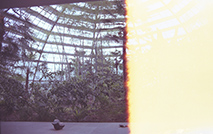How do we understand Malevich’s ‘Black Square’ today? How do we focus on its empty void that in the 1915 exhibition, 0.10 in Petrograd, reduced art to a promise of zero: where art had no icon, no image, no imagined state in its gaze and where, hopefully, art could start again and zero could be moved on from.
How does the ‘Black Square’ haunt art now? The artists in the exhibition The Absent Image, curated by Elene Abashidze in Tbilisi’s Gallery Nectar reflect upon this exactly 100 years since 0.10.
Imran Perretta’s work ‘FSWAD’ (2015) is two sheets of foil blankets on whose surface skin whitening cream mixed with white emulsion paint leaves two silver parts distanced from each other. The silver feels torn apart, and more visible now, perhaps despite being so. They sit above a plastic mosque that is placed on top of a plastic bag with an alarm clock nearby. It looks like it’s on top of a cloud, difficult to place.

Tbilisi born and New York-based Anna K.E.’s video from 2011 is projected on the wall. ‘Enough Sugar’ shows the artist pulling herself across a studio floor on a rectangle shape made of white tiles. She sits on the tiles as though there’s something terrible on the ground that she can’t touch and moves things out of the way with sticks as she makes her way painfully and slowly across. The camera is always behind her, filming her back, which is working hard. Somehow it is difficult to call the rectangle of white tiles ‘a boat’ and it is too simple to say she is ‘rowing’.
Gio Sumbadze, who was recently interviewed by Tbilisi-based Abashidze about the deep connection between Western-centric ideas of acceleration, and more historical understandings of utopia shows ‘Map of Nowhere’ (2015). It is a series of pencil drawings, torn from a sketch book and nailed to the wall, all in a row. The maps are not directive. They are flat, like photographs of roses taken from above, caught just as they are -imaged and not signifying. They do not lead anywhere and somehow there is a correlation between looking at them and looking at ‘Enough Sugar’, which holds a view also from slightly above and behind.
Presented in a wooden vitrine as an archive is Nikita Kadan’s work ‘Yesterday, Today, Today’ (2012). Small and portrait marble and granite blocks are lined up together, some with fronts coated in coloured tape while Sophie Jung’s piece is two paired-back and silently installed iPod minis. The title of Jung’s piece is ‘COS of the Grand Change, and dada: art is to be explored: it is not to discover just one way to paint, a painter must always try neeeew ways to paint’ (2015). Perhaps it’s a small request to focus-in on the present tense. Jung’s pitch of “Art is to be explored” against “it is not to discover just one way to paint” might pose a disconnection in the one-way flow or current route that art often takes to define an imagined and imaged future. **
Exhibition photos, top right.



